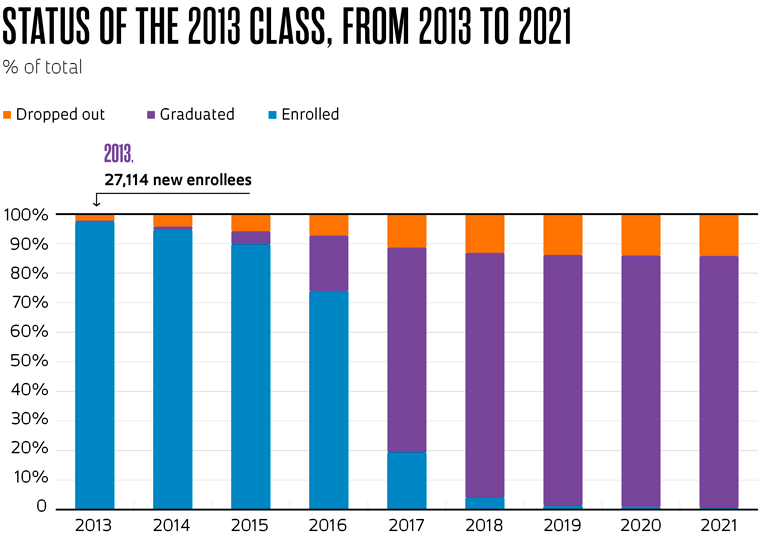- A previous study (see Pesquisa FAPESP issue nº 313) showed a significant reduction in the number of people completing doctorates in Brazil since 2020, partly due to the COVID-19 pandemic. What needs to be assessed now is whether this decline was accompanied by an increased dropout rate among PhD students
- The most accurate way to estimat dropout rates is by monitoring the number of new enrollees per year over time
- The graph below shows the outcomes among the group of students that began a PhD in 2013. Originally totaling 27,114 students, almost everyone in the 2013 class had completed the course or dropped out by 2021, eight years after the start of the course, making it possible to estimate the final completion and dropout rates

- The class of 2013’s completion rate (graduated/enrolled) in 2021 was 85%, with 14% having dropped out and 1% still enrolled as students. Similar progression is observed for the classes of 2014 and 2015
- To assess the effects of the pandemic on these figures, the progress of the classes of 2015 and 2017 were compared until the 5th year after enrollment, when according to the graph for the class of 2013, about 70% of students should have completed their PhD

- As expected, about 70% of students in the class of 2015 had graduated by the 5th year after enrollment, while the same was only true of 50% of the class of 2017. In the latter, the 4th and 5th years of study took place during the pandemic
- However, the decline in the number of students graduating was not accompanied by an increase in the number of dropouts, which was almost identical in both groups in the 5th year, at around 10%
- The proportion of students who remained enrolled increased significantly, with the class of 2017 at almost double the class of 2015 in the 5th year after enrollment (40% compared to 20%), offsetting the low number of graduations
- The conclusion is that the pandemic negatively impacted the number of students graduating from recent classes, but there is no evidence of a significant increase in dropouts; instead, we’ve seen a growth in students still enrolled in their course

Sources Microdata from the Sucupira base, CAPES/MEC, downloaded in January 2023 Prepared by The FAPESP Studies and Indicators Team (DPCTA)
Republish